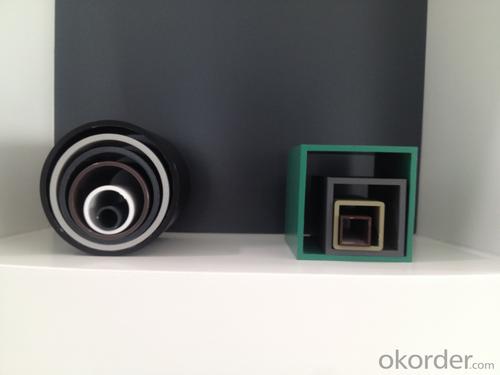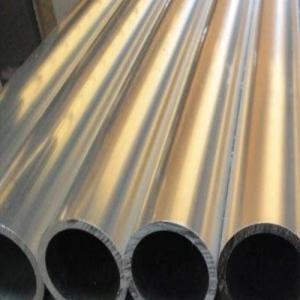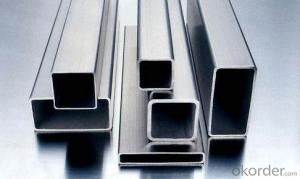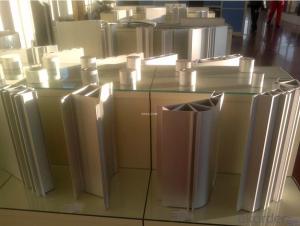Aluminum Seamed Tube Pipes
OKorder Service Pledge
OKorder Financial Service
You Might Also Like
We are the largest aluminum profilemanufacture in
Provide full size of seamed tubes:
Diameter(Out):7.54mm-573mm
Wall thickness:1mm-44mm
Material | Alloy Aluminum 6063,6061,6005,6082 or customer nominated |
Temper | T3, T4, T5, T6 and other |
Surface | Anodize, electrophoresis, powder coating, PVDF coating, wood grain painting, etc. |
Colour | Any colour based on Standard Germany RAL Mark |
Length | Not more than 16 meters |
Good Package | Inner plastic film /outside carton/wooden pallets |
Payment Method | T/T, L/C, etc |
Delivery Time | Normally 2-4 weeks, Delivery time can be consulted. |
Press Machine | 500-12500 tons all together 93 press lines. |
Fabrication | 1. Furniture 2. Drilling; 3. Bending; 4. Cutting; 5. etc. |
Certificate | ISO/TS 16949,DNV,IRIS,CCS,AFA,etc. |
Dies | 1. Using our dies, no fee; |
2. Using customer drawing, opening dies, usually about 5~50 tons then the dies cost can be refunded. | |
3. Die cost is negotiable base on the order quantity | |
Capability | Annual output 800,000 tons |
- Q: Are aluminum pipes suitable for food processing applications?
- Yes, aluminum pipes are suitable for food processing applications. Aluminum is a lightweight and corrosion-resistant material which makes it ideal for use in the food industry. It has excellent thermal conductivity, allowing for efficient heat transfer during processing. Aluminum pipes are also hygienic as they can be easily cleaned and sanitized, meeting the strict cleanliness requirements of food processing facilities. Additionally, aluminum is non-toxic and does not react with food, ensuring that the integrity and quality of the processed food are maintained. Overall, aluminum pipes are a reliable and practical choice for food processing applications.
- Q: Are aluminum pipes lightweight?
- Yes, aluminum pipes are generally lightweight. Aluminum is a lightweight material with a low density, making it a popular choice for various applications where weight is a concern. Compared to other metals like steel or iron, aluminum pipes weigh significantly less while still maintaining strength and durability. This makes them ideal for use in industries such as construction, aerospace, automotive, and plumbing, where reducing weight is important for efficiency and performance. Additionally, the lightweight nature of aluminum pipes makes them easier to handle, transport, and install compared to heavier materials.
- Q: What are the different insulation options for aluminum pipes?
- Some common insulation options for aluminum pipes include fiberglass insulation, foam insulation, and elastomeric insulation. These materials help to reduce heat loss or gain, prevent condensation, and improve energy efficiency in the piping system.
- Q: Can the air conditioner low pressure pipe and high pressure pipe be expanded with aluminium pipe at the two ends?
- Yes, but the aluminum tube is easy to crack. Be very careful. I opened a shop maintenance for seven or eight years, only a few times with aluminum pipe to do the bell mouth, the problem is not, just be careful. Of course, it is recommended to use brass bell mouth, good toughness, not easy to crack.
- Q: What are the specifications of aluminium tubes?
- Shanghai pan bamboo company specializing in the production of aluminum pipe, thin-walled tubes, thick walled tubes, small diameter tubes, large diameter tubes, small caliber thin-walled tubes, small caliber thick wall pipe, large diameter thin-walled aluminum tube, large diameter thick walled tubes, various specifications of aluminum rodNo specifications can be customized to find Ke Chunquan Oh, I hope to help you oh!
- Q: Can aluminum pipes be used for marine applications?
- Yes, aluminum pipes can be used for marine applications. Aluminum is known for its excellent corrosion resistance, lightweight nature, and durability, making it a suitable choice for various marine applications such as boat building, shipbuilding, and offshore structures.
- Q: Are aluminum pipes suitable for pharmaceutical manufacturing?
- Aluminum pipes indeed possess the potential to be appropriate for pharmaceutical manufacturing. Thanks to its manifold advantageous properties, aluminum stands as a frequently employed material in the pharmaceutical sector. Being lightweight, resistant to corrosion, and easily sterilizable, it emerges as an ideal choice for situations where cleanliness and hygiene hold utmost importance. Furthermore, aluminum pipes offer the convenience of malleability, enabling the creation of diverse shapes and sizes, thereby facilitating the design of pharmaceutical equipment. Nonetheless, one must bear in mind that certain medications or substances could potentially react with aluminum. Thus, it is crucial to carry out compatibility tests to ascertain the suitability of aluminum pipes for specific pharmaceutical manufacturing processes.
- Q: Which is the high price of 6063 and 6061 aluminium tubes?
- The same material profiles, the average length of the same unit, the weight of the high price.
- Q: Are aluminum pipes suitable for outdoor use?
- Indeed, aluminum pipes prove to be fitting for outdoor utilization. Aluminum, being an incredibly adaptable and enduring substance, exhibits remarkable resistance against rust and corrosion. Its exceptional aptitude to withstand various weather conditions renders it ideal for outdoor applications. Consequently, aluminum pipes find common employment in a multitude of outdoor scenarios such as construction sites, irrigation systems, outdoor furniture, and outdoor structures. Moreover, their lightweight nature and effortless maneuverability render them a convenient option for outdoor installations. All in all, aluminum pipes stand as a dependable and enduring alternative for outdoor utilization.
- Q: Are aluminum pipes suitable for oil rig platforms?
- Under certain conditions, aluminum pipes can be considered suitable for oil rig platforms. These pipes possess several advantages that make them a viable choice for such applications. Firstly, aluminum is lightweight in comparison to materials such as steel, making it easier to transport and install on offshore platforms. This reduction in weight can also lead to cost savings during both the construction and operation phases. Secondly, aluminum exhibits excellent resistance to corrosion, which is crucial in marine environments where oil rigs are situated. This resistance ensures that the pipes can endure harsh conditions, including exposure to saltwater and other corrosive elements. Furthermore, aluminum pipes possess a high strength-to-weight ratio, meaning they offer significant structural integrity while remaining relatively light. This strength is vital for supporting heavy loads and withstanding the dynamic forces encountered on oil rig platforms. However, it is important to acknowledge that aluminum pipes have limitations. In particular, they may not be suitable for all sections of an oil rig platform, especially in areas that involve high pressure and extreme temperatures. In such cases, materials like steel may be more appropriate due to their superior strength and ability to withstand extreme conditions. In conclusion, aluminum pipes can be a viable option for oil rig platforms, particularly in areas where considerations such as weight reduction, corrosion resistance, and moderate strength are important. Nevertheless, it is crucial to carefully evaluate the specific requirements and conditions of the platform to determine the most suitable material for each section.
Send your message to us
Aluminum Seamed Tube Pipes
OKorder Service Pledge
OKorder Financial Service
Similar products
Hot products
Hot Searches
Related keywords
























